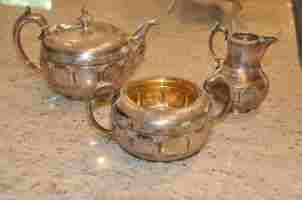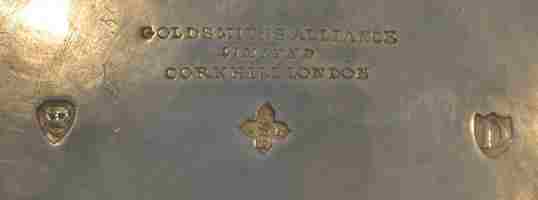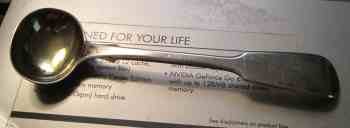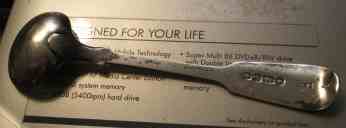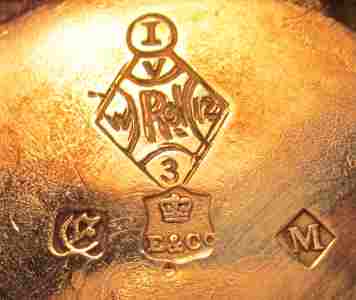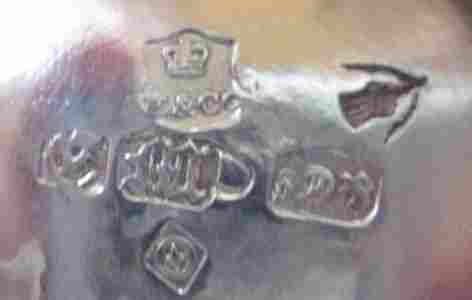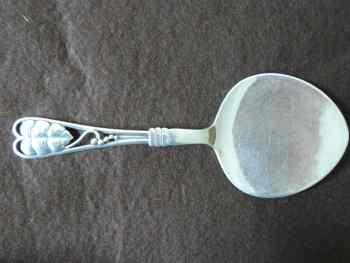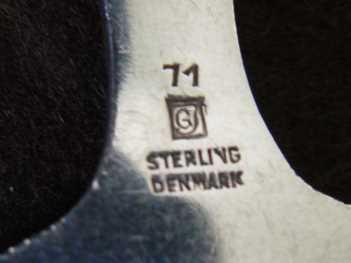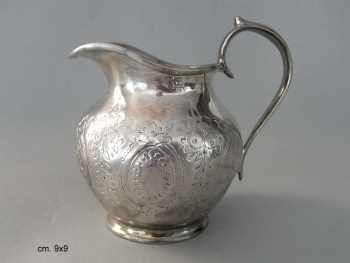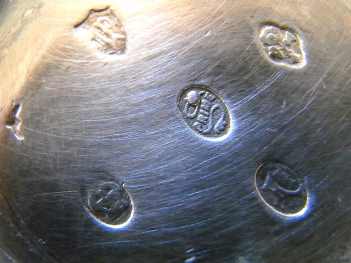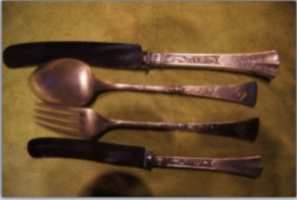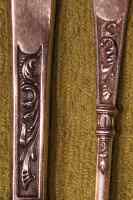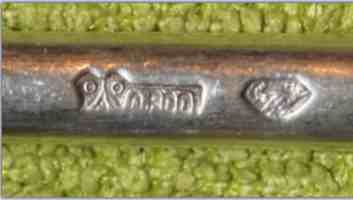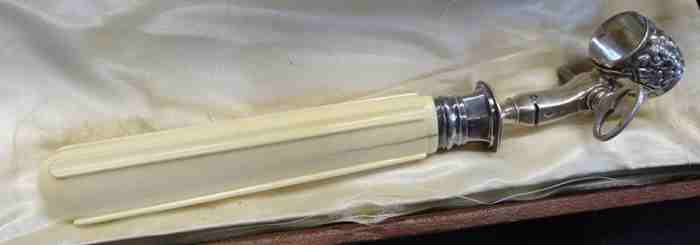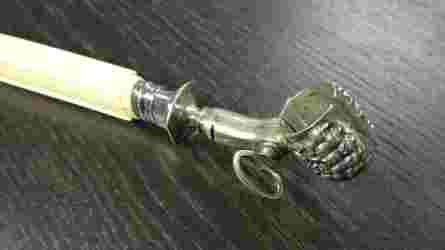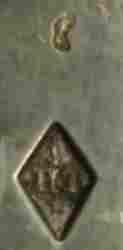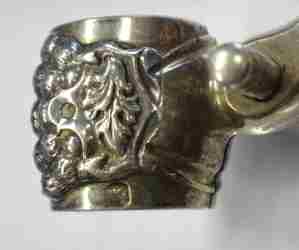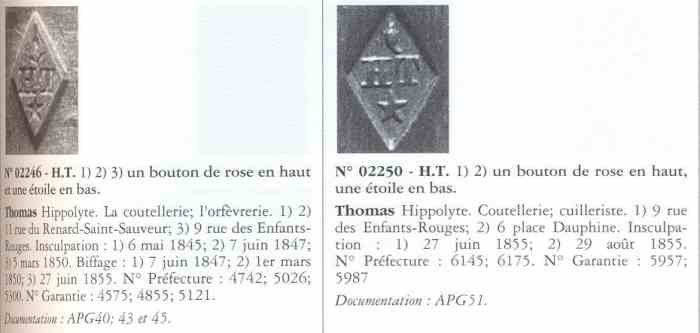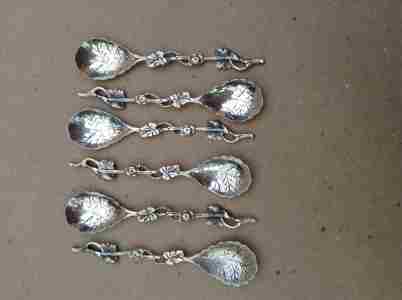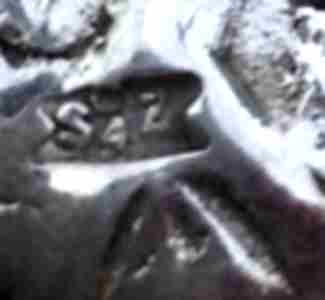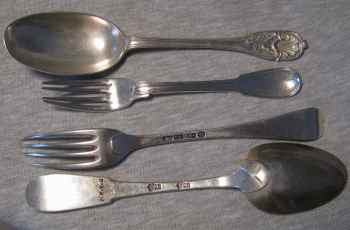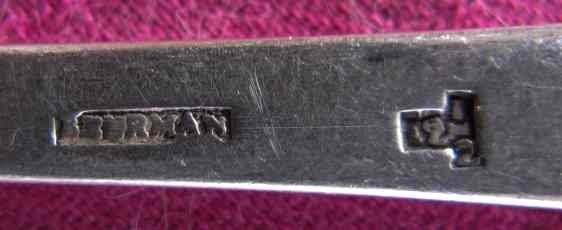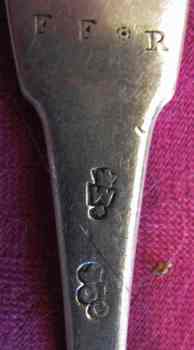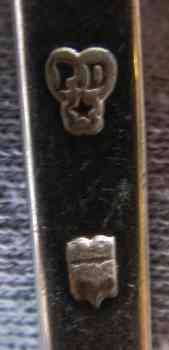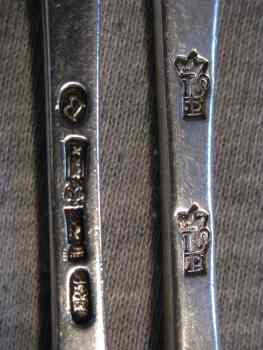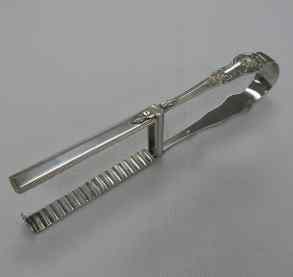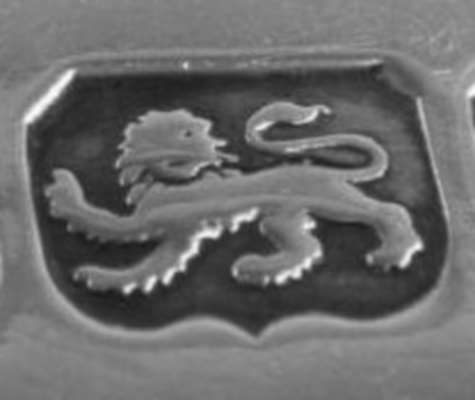
David McKinley presents:
The Mystery of the Sterling Lion

Arguably the best known and most widely respected mark
of quality ever created was what is now called the
‘sterling’ lion. There is, however, a mystery
surrounding its use since it has never been established
what it was originally designed to represent. It may
have been intended to indicate that Goldsmiths' Hall was
now (1544) under the control of the king since the
Goldsmiths' Company had been obliged to surrender its
charter in that year, the year of its introduction, but
there is no reference to it in the Company's records.
Legislation dealing with the marking of plate wrought in
England, has always had to do with those marks which
must be applied to a piece of plate which has been
assayed as of the required standard. No law has ever
been passed dictating that any mark must not be applied
to such plate. It is a fact that any one of us is quite
at liberty to punch whatever marks we choose on our
plate so long as that plate, if of a legal standard,
also carries the marks dictated by legislation....
click here

|
Welcome to new ASCAS members:
Edouard de Sevin - French West Indies
Stephen Hembley - England UK
Becky Wilke Richardson - USA
Patrick Ridley - USA
Michael Thomas - USA
Blake Raymond writes:
... I was hoping you could provide me with a little more
information about some sterling silver I have.
According to who I purchased it from in 1999 and your website
the silver dates back to 1879. However, I cannot figure out the
initials which are ASH with a J above and an E below.
Any information you could provide me would be greatly
appreciated. Thank you in advance.
Blake Raymond
The initials refers to Joseph, Albert, Horace & Ethelbert
Savory (see my website at
http://www.silvercollection.it/englishsilvermarksXJ.html )
The Goldsmiths' Alliance Ltd (1866-1893) late A.B. Savory & Sons
(1835-1866) was incorporated in 1893 by The Goldsmiths &
Silversmiths Company (see my website at
http://www.silvercollection.it/ENGLAGOLDSMITHS&SILVERSMITHS.html
)
Giorgio Busetto
Teresa Shane writes:
... My father had this in a collection of display items and I
found the following marks, as shown on the photos.
Can you help me identify the maker and what the marks mean?
Thanks,
Teresa Shane
Your salt spoon bears hallmarks of London Assay Office, date
1841, maker James Beebe. This mark was entered in London Assay
Office on 3rd August 1839 (see my website at
http://www.silvercollection.it/englishsilvermarksXJ2.html )
Giorgio Busetto
Frank Yolango writes:
... I have a teaset bearing on the bottom this marks. I'd wish
to have some information about its origin and date
Thanks,
Frank Yolango
These are silverplate marks of Elkington & Co. The dates are
1851 and 1853 (see my website at
http://www.silvercollection.it/Elkington.html ).
The lozenge/diamond is the registration date of the pattern at
the UK Patent Office (the date is 1850, see my website at
http://www.silvercollection.it/dictionarylozengemark.html ).
The thistle on the right is, possible, a workman mark (see the
column ""A Page per Month" in this newsletter)
Note on the photo on the right the use of the mark in the form
of Elkington, Mason &Co and the "&Co" punched upside down)
Giorgio Busetto
Paola Continella writes:
... I bought this milk jug as silverplate, but I'm unable to
identify the maker.
Thanks for your help,
Paola Continella
Gordon Doyle writes:
... I have been looking at your site as I have just bought a
boxed set of six spoons bearing the marks W&H S D A1 pennant.
I was hoping to determine their age.
Kind Regards,
Gordon Doyle
Simon Buxton writes:
Hi Giorgio,
I am trying to find details about British silver and plated
articles with inset coins. Examples are commonly found in ladle
bowls, tankard and box lids.
I would like to know if such articles were ever made with
contemporary coins?
I suspect that obsolete coins, both silver and copper, such as
pennies minted prior to 1860 when the size was changed, were
either attached to new goods or retro-fitted to earlier articles
in Victorian times.
Perhaps you or your members can provide more information on this
topic?
Regards
Simon Buxton
Dan Free, Jean-Gabriel Lamorte, Lynette MacDonald, Robert
Massart write
The maker's mark Giotto Bargigia is looking for belongs to
Hippolyte Thomas, 11 rue du Renard Saint-Sauveur, Paris and
later 9 rue des Enfants Rouges, Paris. He worked during the
period 1845-1855 and was registered as a cutlery and spoon
maker.
Symbol : a rosebud over a star (un bouton de rose en haut et une
étoile en bas).
He was succeeded by Thomas & Hénin.
The item is indeed a "Manche à gigot" or lamb chop holder as you
correctly identified. Such items were usually sold with a
matching fork to form a "couvert à gigot".
Leo van Retep writes
We are looking at a Dutch maker's mark S4Z in an anvil
shaped rectangular shield for:
Fa. (Firm) Steenkist & Zweed, located in the city of Haarlem
during 1949-1954. Please check for a Dutch silver standard mark,
the sword mark for minimum .833 fineness.
Leo van Retep
Janjaap Luijt writes
The mastermark S4Z is used by the Dutch firm Steenkist &
Zeed (1949-1954). They were located in Haarlem. The spoons most
likely also bear the mark with the sword used in the
Netherlands.
Janjaap Luijt
Charles C. Cage writes
I can clear up another three-fifths of the mystery: most of
Mr. Du Pasquier's flatware is, as he thought, Swiss.
The marks with the crowned "W" and "CL/G" are those of
Claude-Louis Gleises (1727-1771) of Vevey, Canton Vaud.
The "W" is actually two interlaced "V"s and represents the city
arms of Vevey.
Vaud silver was generally either 11 or 10 deniers fine (.916 or
.833) and, if not specifically marked, was usually the higher of
the two.
The "PD" mark with a shield is that of Papus & Dautun of
Lausanne, Canton Vaud (The shield, again, represents the
Lausanne civic arms).
This was the partnership of Elie Papus (1713-1793) and
Pierre-Henri Dautun (1729-1803), which was formed around 1760
after Dautun had married a sister of Papus' wife.
The firm – Lausanne's most prolific and prestigious of the time
– continued until Papus' death, after which Dautun ran the
company under his own name until his death ten years later.
Finally, the "IS/P" mark struck twice is almost certainly that
of Jacques-Sigismond Pottin (1746-1816), master 1780 in Geneva,
Canton Geneva.
In pre-Napoleonic Geneva, the maker's mark struck twice
indicated the second standard fineness of 10 deniers, or .833.
(First standard pieces of 11 deniers or .916 were struck with
both an assayer's mark and a maker's mark, whereas third
standard pieces of 9 deniers or .750 were struck with a single
maker's mark only).
I hope someone else can identify the "BEURMAN" mark –
unfortunately, I have had no luck in identifying it.
Charles C. Cage
In this column we presents a page obtained from makers'
brochures, books, auction catalogs, advertising or whatever
other printed paper, related to silver, that may be of interest
for ASCAS members.
The images will be published at a "low resolution" level and for
private and personal use only
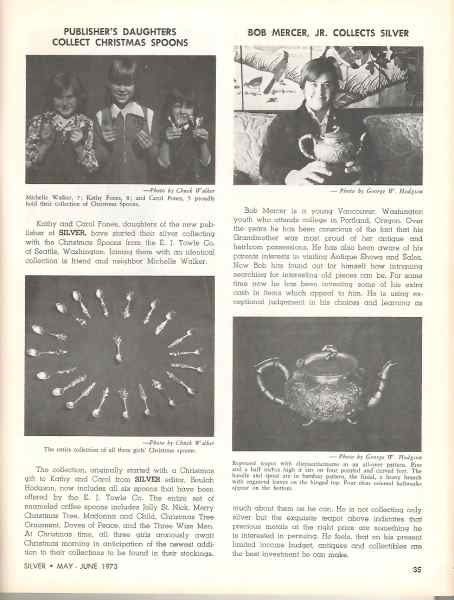
|
This month ASCAS presents a page from MAY-JUNE 1973
issue of Silver Magazine
BOB MERCER, JR COLLECTS SILVER
Some times ago I received this mail:
Hello George,
I am contacting you because I found your website and saw
that you have a collection of Silver Magazines. I am
trying to locate an older copy from the 1970's.. I
realize that you may not have this particular one for
sale but maybe you can help me find out which issue I am
looking for..
Here is my story:
My name is Lisa Mercer and Beulah Hodgson was my next
door neighbor when I was growing up in Vancouver,
Washington. Back when I was in grade school, Beulah
wrote a couple of articles on both myself and my
brother, Bob. I am trying to find the issue that we were
in. I believe it was the same issue. What information I
have is that I believe the issue was sometime between
1973-1975, I believe I was around 11 or 12 at the time
and I was born in 1963. I was featured in the magazine
with my collection of figural spoons. My brother Bob
Mercer was featured with a Chinese silver teapot I
believe.
I would certainly appreciate some assistance in locating
the issue that we were in. I looked on your website and
have also looked on silvermag's website by trying to
search Beulah's articles and anything relating to
figural or souvenir spoons and came up fruitless.
Please let me know what you find. If even just the date
of the magazine, I would be very thankful.
Best Regards,
Lisa
After a research on my collection of Silver magazine
I found the article Lisa was looking for. It’s in
May-June 1973 issue of Silver Magazine, but the page
deals only with Lisa's brother, Bob Mercer, and his
silver teapot. I own most of 1973-1974 and 1975 issues
of the magazine but I was unable to find an article
dealing with Lisa and her collection of figural spoons.
I hope that, 40 years later, other member of ASCAS can
search in their collection of the magazine and verify in
the missing issues the possible presence of another
article dealing with Lisa and her spoons.
Giorgio Busetto
|
"A WORD per MONTH"
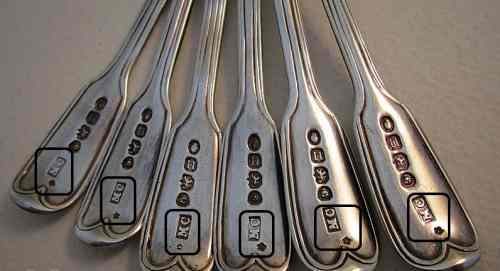
JOURNEYMAN MARK
WORKMAN MARK
The word journeyman comes from the French word
journée, which means a period of one day.
The title refers to the journeyman's right to charge a
fee for each day's work.
In origin he was "a man who did not gain the freedom of
the City and was therefore a 'non Freeman' but was free
of a livery company and thus qualified to ply his trade
could do so as a 'journeyman' provided he was licensed
by the corporation. Often he would continue to work for
his old master in the capacity of journeyman but he
could, if he wished, go to another workshop and
sometimes a silversmith would remain a journeyman for
all of his working life" (courtesy David
Mckinley/ASCAS).
The majority of silversmiths never actually registered
their own mark. .....
more
|
"A SILVERSMITH per MONTH"
|
|
CHAWNER & CO (GEORGE WILLIAM ADAMS)
(successors to WILLIAM CHAWNER II - MARY CHAWNER -
MARY CHAWNER & CO
The business was founded in
1815 by William Chawner II who was apprenticed to
William Fearn in 1797.
Free in in 1804 he entered his first mark as spoonmaker
in 1808 in partnership with William Eley and William
Fearn.
The partnership was dissolved c. 1814 and William
Chawner II entered his first mark alone in 1815. After
his death (1834) the business was continued by his widow
Mary (née Burwash).
Later, Mary Chawner took into partnership (1840) her
son-in-law George William Adams (husband of her daughter
Mary Ann), who, after her retirement (or death) managed
the business as Chawner & Co and remained sole partner
until 1883. In this year Chawner & Co was sold to
Holland, Aldwinkle & Slater (1883-1922, when the firm
was absorbed by Francis Higgins & Son Ltd).....
more
|
Closing our SEPTEMBER 2013 edition of
ASCAS Newsletter I hope you have appreciated its content.
Your comments, suggestions and advice will be of great help.
My thanks to Simon Buxton, Charles C. Cage, Paola Continella,
Marc Deconinck, Charles Deheselle, Gordon Doyle, Dan Free,
Jean-Gabriel Lamorte, Lynette MacDonald, Robert Massart David
McKinley, Lisa Mercer, Blake Raymond, Leo van Retep, Teresa
Shane and Frank Yolango for their precious contributions.
Giorgio Busetto
Secretary
DISCLAIMER AND PRIVACY POLICY
ASCAS is a community of people having a common
interest in antique silver.
It is a non-profit association without commercial links.
Membership is open to whomever has a true interest in
this subject matter.
ASCAS has no real property and no fees are requested nor
accepted from members.
ASCAS keeps in touch with its members only through
periodical newsletters, e-mails and web-site updating
and ignores and is not responsible for any other
activity pursued by its members.
Likewise, ASCAS is not responsible for opinions,
evaluation and images displayed, and in any form
published or supplied for publication, by its members
who, in any case, maintain the property of their works
and assure the respect of national and international
legislation about Intellectual Property.
ASCAS does not have the full addresses of its members (only
town, country and e-mail address are requested for
membership).
ASCAS handles and protects with care its members' e-mail
addresses, will not disclose the addresses to third
parties, will use this information only to reply to
requests received from members and for communications
strictly related to its activity.
These rules are expressly accepted by submitting the
membership request.
|
|
 newsletter
# 112 September 2013
newsletter
# 112 September 2013






